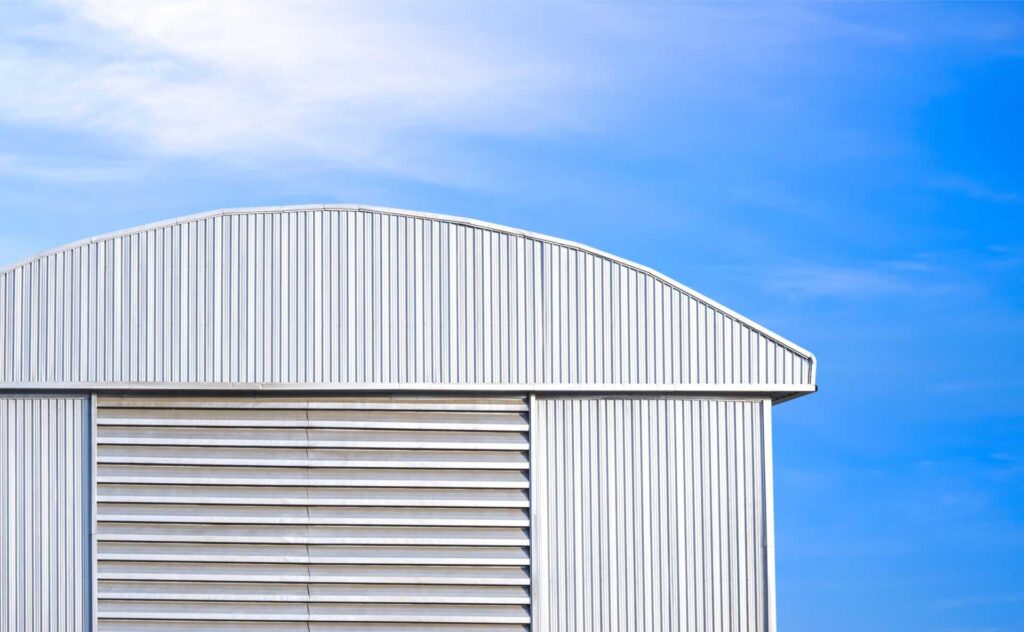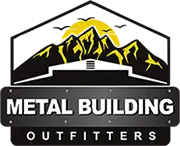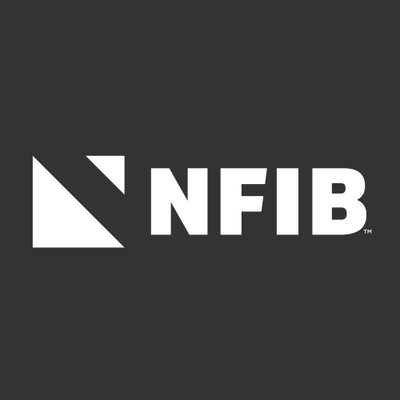
Contents
When creating energy-efficient metal buildings, the key lies in the specifics. Integrating customizable characteristics designed to improve eco-friendliness and efficiency can greatly influence your building’s overall environmental impact. From incorporating solar panels to implementing advanced lighting systems, every part plays a vital role in maximizing energy usage. But how do these characteristics collaborate harmoniously to design an environmentally friendly structure? Let’s delve into the details of these elements and uncover their transformative capacity to shape a greener future.
Key Takeaways
- Incorporate solar panels for maximum energy efficiency.
- Choose insulated roofing systems to control indoor temperature.
- Implement daylighting strategies for natural light optimization.
- Apply cool roof coatings to reduce energy consumption.
- Utilize high-efficiency lighting systems like LEDs.
Solar Panel Integration
To maximize energy efficiency, contemplate incorporating solar panels into your metal building design for enduring power generation. When planning the positioning of solar panels, make sure they’re installed on a section of the roof with maximum sunlight exposure throughout the day. This strategic placement will enhance energy generation and improve the overall efficiency of your solar system.
In addition to solar panel placement, it’s essential to ponder energy storage solutions. By integrating efficient energy storage systems, such as batteries, you can store excess energy generated during peak sunlight hours for later use when sunlight is unavailable. This ensures a consistent power supply even during periods of low sunlight or at night.
To efficiently convert the direct current (DC) electricity produced by the solar panels into alternating current (AC) electricity for use in your building, high-quality inverter technology is vital. Advanced inverters not just assure seamless conversion but also offer features like remote monitoring and system enhancement, boosting the overall performance of your solar power system.
Moreover, connecting your solar panels with the local grid through grid integration technologies allows for smooth energy flow. This enables you to sell excess energy back to the grid, further enhancing the financial benefits of your solar investment while contributing to a more eco-friendly energy ecosystem.
Insulated Roofing Options
Consider improving the energy efficiency of your metal building by exploring different insulated roofing options that can offer superior thermal performance and contribute to substantial energy savings.
When it comes to metal roofing, insulation is crucial to maintaining a comfortable indoor environment while reducing energy costs. Insulated metal roofing systems consist of a layer of insulation material, such as polyurethane foam or mineral wool, sandwiched between the metal panels. This insulation helps control the temperature inside the building by minimizing heat transfer through the roof.
Opting for insulated metal roofing can greatly enhance the overall energy efficiency of your metal building. By reducing heat gain in the summer and heat loss in the winter, these roofing systems can lower your dependence on heating and cooling systems, resulting in long-term energy savings.
Additionally, insulated metal roofing can improve the acoustic performance of your building by reducing external noise and creating a more peaceful indoor environment.
When selecting insulated roofing options for your metal building, consider factors such as the R-value of the insulation, the thickness of the panels, and the specific climate conditions of your location. Investing in high-quality insulated metal roofing will boost your building’s energy efficiency and also contribute to a more environmentally friendly and comfortable workspace.
Daylighting Strategies
Enhance the natural lighting in your metal building by implementing effective daylighting strategies that maximize the use of sunlight to reduce energy consumption and create a brighter indoor environment.
To achieve this, consider the following:
Skylight Installations: Skylights are a great way to introduce natural light into your metal building. By strategically placing skylights on the roof, you can illuminate interior spaces with sunlight, reducing the need for artificial lighting during the day. Additionally, skylights can enhance the aesthetics of the building and create a more open and inviting atmosphere.
Window Placement: Proper placement of windows is essential for optimizing daylighting in your metal building. When designing your building, carefully consider the orientation and size of windows to maximize the entry of natural light. South-facing windows tend to receive more sunlight throughout the day, while overhangs or shades can help control the amount of light and heat entering the building.
Light-Reflective Surfaces: Utilizing light-reflective surfaces within your metal building can help distribute natural light more effectively. Consider using light-colored interior finishes, such as walls, ceilings, and flooring, to bounce light around the space and minimize the need for additional lighting fixtures. Additionally, incorporating light-reflective roofing materials can further enhance daylighting and reduce energy consumption.
Cool Roof Coatings
Implementing cool roof coatings on your metal building can greatly reduce heat absorption and energy consumption. These reflective coatings are a key component of cool roof technology, offering significant energy savings and environmental benefits. By applying cool roof coatings, you can lower the roof temperature, decreasing the need for air conditioning and ultimately cutting down on your energy bills.
Cool roof technology works by reflecting sunlight and heat away from the building rather than absorbing it. This process helps maintain lower roof temperatures, reducing the heat transferred into the interior spaces. As a result, your metal building stays cooler during hot weather, enhancing comfort for occupants and decreasing the load on cooling systems.
Besides the energy savings they provide, cool roof coatings have a positive environmental impact. By reducing the energy required for cooling, these coatings help lower greenhouse gas emissions associated with electricity generation. Additionally, cooler roofs can mitigate the urban heat island effect, where urban areas experience higher temperatures due to heat absorption by buildings and pavement.
Incorporating cool roof coatings into your metal building can improve energy efficiency, decrease operational costs, and contribute to a more environmentally responsible environment. Consider this technology as a valuable option when customizing your metal building for peak performance and environmental responsibility.
High-Efficiency Lighting Systems
When considering high-efficiency lighting systems for your metal building, focus on the benefits of LED lighting.
Incorporating smart lighting controls can further enhance energy savings and provide customized lighting solutions for your building’s needs.
Additionally, implementing daylight harvesting strategies can maximize natural light usage, reducing reliance on artificial lighting sources.
LED Lighting Benefits
Maximizing energy efficiency in metal buildings often involves integrating high-efficiency LED lighting systems to decrease electricity consumption and operational costs. LED lighting offers significant advantages that extend beyond mere cost savings. Here are some key benefits:
Energy Efficiency: LED lights are highly energy-efficient, consuming considerably less power compared to traditional lighting systems. This efficiency results in lower electricity bills and reduced operational costs over time.
Longevity: LED lights have a longer lifespan than traditional lighting options, reducing the frequency of replacements. This saves on maintenance costs and minimizes the environmental impact of disposing of old light fixtures.
Environmental Impact: LED lighting is eco-friendly as it consumes less energy, reduces carbon emissions, and contains no harmful substances like mercury. By transitioning to LED lighting in your metal building, you’re contributing to a greener and more sustainable environment.
Integrating LED lighting into your metal building design can lead to long-term cost savings, increased efficiency, and a positive environmental impact.
Smart Lighting Controls
For improved energy efficiency in metal buildings, consider integrating smart lighting controls as part of your high-efficiency lighting systems. Smart lighting controls offer remote access capabilities, allowing you to adjust and monitor your building’s lighting from anywhere, promoting convenience and efficiency.
Utilizing these controls allows you to schedule lighting based on occupancy patterns, ensuring lights are solely on when needed, leading to significant energy savings. Remote access features enable you to dim or turn off lights in unoccupied areas effortlessly, reducing unnecessary energy consumption.
Additionally, smart lighting controls can provide real-time data on energy usage, allowing you to make informed decisions to enhance energy efficiency in your metal building further. Through the implementation of smart lighting controls, you not just enhance the sustainability of your building but also contribute to long-term cost savings through reduced electricity bills.
Embracing these technologies is a practical and effective way to create a more energy-efficient and environmentally friendly metal building.
Daylight Harvesting Strategies
Consider integrating daylight harvesting strategies as part of your high-efficiency lighting systems to maximize natural light utilization within your metal building. Daylight harvesting involves using sensors and controls to adjust artificial lighting levels based on the amount of natural light available, leading to significant energy savings and a more sustainable building operation.
When designing your daylight harvesting system, keep the following benefits and design considerations in mind:
Natural Light Utilization: Harnessing natural light decreases the need for artificial lighting during daylight hours and creates a more comfortable and visually appealing indoor environment for occupants.
Energy Savings: By optimizing the use of natural light, you can reduce energy consumption related to lighting, resulting in decreased electricity costs and a smaller environmental footprint.
Design Considerations: When incorporating daylight harvesting, make sure of proper placement of sensors, consider building orientation for maximum light exposure, and integrate automated controls to smoothly adjust lighting levels throughout the day.
Energy-Efficient Windows
To enhance the energy efficiency of your metal building, prioritize selecting windows designed with advanced insulation properties. Energy-efficient windows play a pivotal role in reducing heat transfer, air leakage, and overall energy consumption.
When choosing windows for your metal building, consider options such as smart glass, which can dynamically adjust its tint to control heat and light entering the building. Also, look for windows with high energy ratings, indicating their ability to insulate and reduce heat loss or gain effectively.
Smart glass, also known as switchable glass, uses cutting-edge technology to regulate the amount of heat and light passing through. This feature helps enhance natural lighting while minimizing the need for excessive heating or cooling systems, ultimately saving energy.
Moreover, windows with high energy ratings are specifically designed to prevent thermal bridging and air infiltration, keeping your metal building well-insulated throughout the year.
Ventilation Solutions
Consider incorporating natural airflow options into your metal building design to enhance ventilation.
Additionally, proper insulation should be focused on to enhance cooling efficiency and reduce the need for excess energy consumption.
Explore automated ventilation systems as a smart solution for maintaining air quality and temperature control within your metal building.
Natural Airflow Options
Explore different natural airflow options to enhance ventilation in metal buildings, ensuring ideal air circulation and comfort for occupants.
When designing your metal building, consider the following natural airflow options:
Natural Ventilation: Incorporate openings such as windows, louvers, or vents strategically placed to allow fresh air to enter and stale air to exit, promoting a continuous flow of air within the building.
Cross Ventilation: Utilize the layout of your metal building to create pathways for air to flow horizontally, enhancing the circulation of fresh air throughout the space and preventing stagnation.
Roof Ventilation: Implement roof vents or cupolas to facilitate the release of hot air that accumulates at the top of the building, helping to regulate temperature and maintain a comfortable environment inside.
Insulation for Cooling
Implement insulation solutions that enhance ventilation and regulate internal temperature effectively to improve the cooling efficiency of your metal building. When it comes to insulation for cooling, utilizing reflective surfaces can substantially reduce heat absorption and keep the interior of your building cooler. Reflective materials like aluminum foil-backed insulation can help bounce off sunlight and prevent excessive heat gain. This is a key aspect of green building practices, promoting energy efficiency and reducing the need for constant air conditioning.
To illustrate the effectiveness of reflective surfaces for cooling, consider the table below showcasing different types of insulation materials commonly used in metal buildings:
| Insulation Material | Description |
|---|---|
| Aluminum Foil Insulation | Reflects heat away from the building |
| Spray Foam Insulation | Provides airtight seal and insulation |
| Fiberglass Insulation | Good thermal resistance properties |
| Radiant Barrier | Reflects radiant heat away |
| Cellulose Insulation | Made from recycled paper, eco-friendly |
Automated Ventilation Systems
Enhance the energy efficiency of your metal building by integrating automated ventilation systems that improve airflow and maintain a well-ventilated environment. Automated ventilation systems are essential for maintaining ideal indoor air quality and temperature control.
By incorporating smart sensor technology, these systems can effectively monitor and adjust ventilation based on real-time data, ensuring a comfortable and healthy environment while reducing energy consumption. Energy-saving controls enable the ventilation system to operate at peak efficiency, adjusting airflow as necessary to minimize energy wastage.
Ventilation Solutions:
Smart Sensor Technology: Utilize sensors to monitor indoor air quality and regulate ventilation accordingly.
Energy Saving Controls: Implement controls that enhance ventilation settings for energy efficiency.
Real-time Monitoring: Enable systems to adjust airflow based on immediate environmental conditions.
Thermal Building Envelopes
Constructing a well-designed thermal building envelope is necessary to improve the energy efficiency of metal buildings. Thermal envelope enhancements play an important role in creating energy-saving designs that promote eco-friendly building envelopes. By implementing thermal efficiency techniques in the construction of the building envelope, you can greatly reduce heat transfer, minimize energy consumption, and enhance overall comfort within the structure.
One key aspect of thermal building envelopes is the insulation system. Choosing high-quality insulation materials and ensuring proper installation can effectively prevent heat loss during the colder months and heat gain during the warmer months. Additionally, utilizing advanced insulation techniques such as continuous insulation and thermal breaks can further improve the thermal performance of the building envelope.
Another important consideration for maximizing the thermal efficiency of metal buildings is the design of windows and doors. Opt for energy-efficient glazing systems that offer excellent thermal performance and minimize air leakage. Proper sealing and weather-stripping around windows and doors are also crucial to prevent drafts and maintain a consistent indoor temperature.
Incorporating reflective roofing materials can further enhance the energy efficiency of metal buildings by reducing heat absorption and lowering cooling costs.
Sustainable Material Selection
Regarding lasting material selection for metal buildings, you should focus on material efficiency tips and eco-friendly options.
Choosing materials that are durable, recyclable, and have a low environmental impact can greatly enhance the durability of your building.
Material Efficiency Tips
Consider choosing eco-friendly materials for your metal building to enhance its material efficiency and decrease its environmental impact. Selecting sustainable options is crucial when striving for material efficiency.
Here are some tips to assist you in making eco-conscious decisions:
Recycled Materials: Opt for materials that have been repurposed or upcycled. Utilizing recycled steel, for instance, reduces the demand for new raw materials and cuts down on energy consumption during production.
Energy Saving Design: Integrate energy-efficient design elements like proper insulation, reflective roofing materials, and efficient HVAC systems. These features can notably diminish energy consumption and decrease your building’s overall environmental footprint.
Choose Sustainable Finishes: Select finishes and coatings that are eco-friendly and have low levels of volatile organic compounds (VOCs). These finishes not just contribute to a healthier indoor environment but also reduce the impact on the ecosystem during manufacturing and disposal processes.
Eco-Friendly Options
For enhanced long-term viability in your metal building project, prioritize utilizing eco-friendly options through sustainable material selection. When considering green building techniques and eco-friendly designs, choosing materials with low environmental impact is vital. Opt for energy-saving solutions and eco-friendly construction practices to reduce your building’s carbon footprint. Below is a table outlining some eco-friendly options for your metal building project:
| Eco-Friendly Option | Description | Benefits |
|---|---|---|
| Recycled Steel | Utilizing recycled steel reduces resource usage | A lower carbon footprint supports environmental preservation |
| Energy-Efficient Windows | Lower carbon footprint supports environmental preservation | Reduced heating and cooling costs, improved indoor comfort |
| Cool Roofs | Roofs designed to reflect sunlight and heat | Decreased energy consumption, enhanced indoor comfort |
Smart Energy Management Systems
Implementing intelligent energy management systems in metal structures can significantly enhance operational efficiency and decrease energy expenses. These systems offer advanced capabilities to monitor, control, and enhance energy usage within your building, providing a more eco-friendly and cost-efficient solution.
Here are key features to consider when integrating intelligent energy management systems:
Real-time Monitoring: Access detailed insights into your building’s energy consumption patterns, allowing you to pinpoint areas for improvement and adjust settings for maximum efficiency.
Automated Controls: Set up automated schedules for lighting, HVAC systems, and other energy-consuming devices to align with occupancy patterns and reduce unnecessary energy wastage.
Integration with Renewable Energy Sources: Connect your intelligent energy management system with renewable energy sources such as solar panels or wind turbines to maximize the utilization of clean energy and further decrease reliance on conventional power grids.
Review
Incorporating energy-efficient features in metal buildings can reduce operational costs and environmental impact. By implementing eco-friendly design strategies, such as solar panel integration and insulated roofing options, you can enhance efficiency and lower energy consumption.
Did you know that metal buildings with cool roof coatings can reflect sunlight, keeping the interior cool and reducing the need for excessive air conditioning? Imagine the savings and comfort that come with this simple yet effective solution.
Recent Posts
Building Strong Steel Structures for Heavy Machinery
When constructing steel structures to support heavy machinery, precision is key. Each element, from the
Efficient Construction of Large Metal Warehouses
When it comes to the optimization of building substantial metal storage facilities, one must consider
Why Choose Energy-Efficient Metal Warehouse Construction?
When it comes to selecting the construction method for your warehouse, choosing energy-saving metal construction


